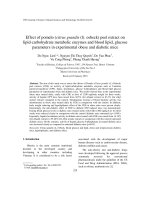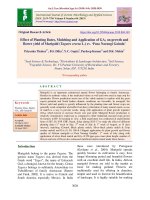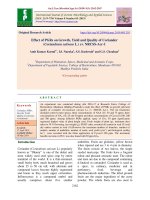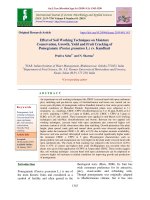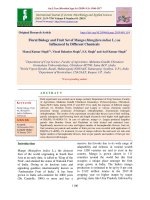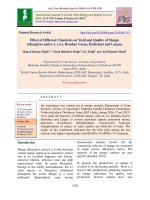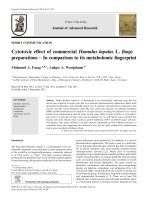Effect of different plant densities and mulches on growth and yield of mango (Mangifera indica L.) cv. alphonso
Bạn đang xem bản rút gọn của tài liệu. Xem và tải ngay bản đầy đủ của tài liệu tại đây (296.81 KB, 9 trang )
Int.J.Curr.Microbiol.App.Sci (2019) 8(6): 3369-3377
International Journal of Current Microbiology and Applied Sciences
ISSN: 2319-7706 Volume 8 Number 06 (2019)
Journal homepage:
Original Research Article
/>
Effect of Different Plant Densities and Mulches on Growth and Yield of
Mango (Mangifera indica L.) cv. Alphonso
B.S. Sagar*, S.I. Athani, S. Raghavendra, J.B. Gopali, Kulapati Hipparagi,
T.B. Allolli, Revanappa and Mallikarjun Awati
Department of Horticulture, College of Horticulture, University of Horticultural Sciences,
Bagalkot, 587-104 (Karnataka), India
*Corresponding author
ABSTRACT
Keywords
Different density,
Mulching, Growth
and yield
Article Info
Accepted:
18 May 2019
Available Online:
10 June 2019
High density planting is a highly efficient and advanced production system of fruit
cultivation. High yield and good fruit quality can be achieved with a high density orchard
in guava when the orchard has good light distribution throughout the tree canopy and there
is a balance between vegetative growth and cropping. To know the effect of high density
planting and different mulches on growth and yield of mango (Mangifera indica L.) cv.
Alphonso was undertaken at Regional Horticulture Research and Extension Centre,
Dharwad (University of Horticultural Sciences, Bagalkot) during May - 2016 to June –
2018. The maximum incremental data of plant height (29.96 cm), plant spread (EastWest) of 32.82 cm was recorded in D4M3 (7.5 × 5 m spacing with plastic mulch) and the
maximum increment of plant girth (1.20 cm) were recorded in D 2M2 (5× 2.5 m spacing
with straw mulch). The treatment D2M3 (5×2.5 m spacing with plastic mulch) recorded the
maximum plant spread of 30.90 cm (North-South), tertiary branches of 26.44 was found
maximum in the treatment D4M1, maximum number of fruits per plant of 52.97 was
recorded in D3M3 and highest yield per plant (14.79 kg) was recorded in D3M3. Whereas,
the treatment D1M3 (2.5× 2.5 m spacing with plastic mulch) recorded the maximum
canopy volume (1.33 cm3). Whereas, the highest number of primary branches of 4.33 was
found in D2M2 and secondary branches (8.83) were recorded in the treatment D4M3 (5.0 x
2.5 m spacing in control). The maximum yield per hectare (13.56) was recorded in D 1M3
(2.5 x 2.5 m spacing with no mulch).
Introduction
Mango (Mangifera indica L) is an important
and king of fruits in India known for its taste
and Alphonso is one of the most expensive
varieties of mango and is grown mainly in the
western part of India including Sindhudurg,
Ratnagiri and Raigad districts of Maharashtra
and in the Konkan region of India. Alphonso
is generally referred to as 'Hapus' in
Maharashtra and Gujarat, also known as
Appus, Badami, Gundu and Khader. It is used
to make sweets, candies and smoothies and
mango drinks. Fruits are orange-yellow in
colour, medium-sized and oval/oblique in
shape. The high density planting technology is
the most viable proposition to increase the
productivity by dwarf tree canopy and for
3369
Int.J.Curr.Microbiol.App.Sci (2019) 8(6): 3369-3377
efficient and profitable land use. Its basic
function is to confine the exploitation zone of
the plant with regard to light, water and
nutrients, so that highest total yield potential
can be realized in the smallest possible area.
The main aim of high density planting is to
produce more and more from unit area, from
one species, in order to make the venture of
tropical fruit production more remunerative
and sustainable. Mulching is the process or
practice of covering the soil/ground to make
more favourable condition for plant growth,
development and efficient crop production.
According to other mulches plastic mulches
are completely impermeable to water;
therefore, it prevents direct evaporation of
moisture from the soil and thus it reduces the
water losses and soil erosion over the surface.
Plastic film with its moisture barrier properties
does not allow the soil moisture to escape
water that evaporates from the soil surface
under mulch film, condenses on the lower
surface of the film and falls back as droplets.
Thus moisture is preserved for several days
and increases the period between two
irrigations (Anonymous, 2014 and Biswas et
al., 2015).
m (1600 plants/ ha), 5.0 × 2.5 m (800 plants/
ha), 5.0 × 5.0 m (400 plants/ ha) and 7.5 × 5.0
m (267 plants/ ha). Each treatment was
replicated three times and four plants were
chosen from each replication. The experiment
was laid out in two Factorial Randomized
Block Design. Growth parameters recorded
during this study viz., plant height (cm), stem
girth (mm), plant spread in both directions
North-South and East-West (cm), canopy
volume (m3), number of primary branches,
number of secondary branches and number of
tertiary branches were measured at 60 days
interval after imposition of treatments, in four
representative plants in each treatment and
average was calculated. For all the vegetative
parameters the final growth and incremental
growth is given. The growth increment was
recorded by calculating the difference
occurred after imposing of treatment to
harvesting and given in results and discussed.
Yield parameters viz., number of fruits
harvested/plant, fruit yield (kg/plant), fruit
yield (tones/ ha) were recorded at the
harvesting time.
Materials and Methods
Vegetative parameters
The present investigation of Studies on high
density planting in mango (Mangifera indica
L.) cv. Alphonso was carried out in Regional
Horticulture Research and Extension Centre,
Dharwad
(University
of
Horticultural
Sciences, Bagalkot) during May - 2016 to
June - 2018. The material used, techniques
adopted and observations recorded during the
course of the investigation are presented in
this chapter. Five year old mango orchard cv.
Alphonso established during 2011 was
selected for the experiment. The pruning was
done after harvesting of fruits in 2016 and
2017. Three different mulches were used viz.,
M1 (no mulch), M2 (straw) and M3 (polythene
mulch). Four different densities like 2.5 × 2.5
Plant height (cm)
Results and Discussion
From the pooled data of both seasons, it is
recorded that the increment in plant height
was varied significantly among the different
planting densities. The increment in plant
height was found maximum in the spacing 2.5
x 2.5 m (23.56 cm) which was followed by the
plants spaced at 5.0 x 2.5 m (21.10 cm)
whereas, the minimum increment was
recorded in 5.0 x 5.0 m (18.08 cm). With
respect to the different mulches, plastic mulch
recorded the maximum plant height increment
(26.41 cm) which was followed by straw
mulch (21.22 cm) while the minimum
increment was noticed in the control (14.76
3370
Int.J.Curr.Microbiol.App.Sci (2019) 8(6): 3369-3377
cm). In interaction effect of spacing and
pruning, significant differences were recorded
in the height increment of the plant. The
highest plant height increment was recorded in
D4M3 (29.96 cm) which was followed by
D1M3 (29.20 cm) and the lowest was recorded
in D4M1 (12.21 cm) (Table 1).
(19.98 cm). Interaction data revealed the
maximum plant spread (East-West) increment
was recorded in D4M3 (32.82 cm) which was
followed by D3M3 (28.68 cm), D4M2 (27.94
cm) and D2M3 (27.14 cm). While the
minimum plant spread (East-West) increment
was recorded in D2M1 (17.98 cm).
Plant girth (cm)
Plant spread North- South (cm)
From the pooled data of both seasons, the
increment in plant girth was varied
significantly among the different planting
densities and mulching. The increment in
plant girth was found maximum in 5.0 x 2.5 m
spacing (0.96 cm), which was followed by 7.5
x 5.0 m (0.88 cm) whereas, the minimum
increment in plant girth was noticed in 2.5 x
2.5 m (0.79 cm) which was on par with 5.0 x
5.0 m (0.79 cm). Different mulches showed
significant difference, increment in plant girth
was found maximum in plastic mulch
(1.07cm) which was on par with Straw mulch
(0.99 cm) and the minimum was recorded in
control (0.54 cm). In interaction effect of
spacing and mulching, the increment in plant
girth was found maximum in D2M2 (1.20 cm)
which was on par with D4M3 (1.14 cm), D3M3
(1.10 cm) and D2M3 (1.09cm). Whereas, the
minimum increment in plant girth was found
in D1M1 (0.45 cm).
Pooled data of two seasons showed, the
maximum plant spread (North-South) was
recorded in treatments 5.0 x 5.0 m (27.48 cm)
and 7.5 x 5.0 m (27.48 cm) which was on par
with the plants spaced at 5.0 x 2.5 m (26.51
cm) and the minimum plant spread (NorthSouth) increment was recorded in 2.5x2.5m
(25.12 cm). Different mulches showed
significant difference, the maximum plant
spread (North-South) increment was recorded
in plastic mulch (31.03 cm) which was
followed by straw mulch (27.95 cm) and the
minimum
plant
spread
(North-South)
increment was recorded in control (20.96 cm).
Interaction data revealed the maximum plant
spread (North-South) increment was recorded
in D2M3 (30.90 cm) which was on par with
D1M3 (30.12 cm), D3M2 (29.55 cm), D3M3
(29.02 cm) and D2M2 (28.17 cm). While the
minimum
plant
spread
(North-South)
increment was recorded in D1M1 (18.30 cm)
and D4M3 (18.30 cm) (Table 2).
Plant spread East- West (cm)
Canopy volume (m3)
Pooled data of two seasons showed the highest
plant spread (East-West) in the plants spaced
at 7.5 x 5.0 m (27.28 cm) which was followed
by 5.0 x 5.0 m (25.69 cm) and the minimum
plant spread (East-West) increment was
recorded in 2.5 x 2.5 m (22.63 cm). Different
mulches showed significant difference, the
maximum plant spread (East-West) increment
was recorded in plastic mulch (28.69 cm)
which was followed by straw mulch (25.07
cm) and the minimum plant spread (EastWest) increment was recorded in control
From the pooled data of 2016-18, the highest
canopy volume increment (1.23 m3) was
recorded in the treatment 7.5 x 5.0 m which
was followed by the treatments 2.5 x 2.5 m
(1.06 m3) and 5.0 x 5.0 m (1.06 m3). Whereas,
the lowest canopy volume increment (1.01 m3)
was recorded in the treatment 5x2.5m.
Different
mulches
showed
significant
difference, the highest canopy volume (m3)
increment (1.39 m3) was recorded in the
treatment plastic mulch which was followed
3371
Int.J.Curr.Microbiol.App.Sci (2019) 8(6): 3369-3377
by the treatment straw mulch (1.11 m3) and
the lowest canopy volume increment (0.77 m3)
was recorded in control. Interaction data
showed that the highest canopy volume
increment (1.72 m3) was recorded in the
treatment D4M3 which was followed by the
treatment D1M3 (1.33 m3) and the lowest
canopy volume increment (0.72 m3) was
recorded in the treatment D2M1 which was on
par with D1M1 (0.76 m3) and D3M1 (0.80 m3).
Number of primary, secondary and tertiary
branches in mango cv. Alphonso
The highest number of primary branches
(4.22) was recorded in the plants spaced at 5.0
x 2.5 m which was followed by the treatment
2.5 x 2.5 m (3.61) and the lowest was recorded
in the treatment 5.0 x 5.0 m (3.07).
in the treatment D3M1 (5.62) which was on par
with D3M2 (5.68).
The highest number of tertiary branches
(25.01) was recorded in the plants spaced at
7.5 x 5.0 m which was followed by the
treatment 5.0 x 2.5 m (24.65) and the lowest
was recorded in the treatment 5.0 x 5.0 m
(21.27). The highest number of tertiary
branches was recorded in control (24.40)
which was on par with plastic mulch (23.87)
and the lowest was recorded in straw mulch
(22.89). Whereas, in interaction of spacing
and mulching, the highest number of tertiary
branches (26.33) was recorded in the
treatment D4M1 which was on par with the
treatment D2M3 (26.20) and D2M1 (26.08)
whereas, the lowest was recorded in the
treatment D3M3 (20.16).
The highest number of primary branches was
recorded in plastic mulch (3.61) but the results
were found non-significant among the
treatments. Whereas, in interaction of spacing
and mulching, the highest number of primary
branches (4.33) was recorded in the treatment
D2M2 which was on par with the treatment
D2M3 (4.25) and D2M1 (4.08) whereas, the
lowest was recorded in the treatment D3M3
(3.00) which was on par with D3M2 (3.08),
D3M1 (3.14) and D4M2 (3.16).
Effect of different plant densities and
different mulches on yield parameters
The highest number of secondary branches
(8.64) was recorded in the plants spaced at 5.0
x 2.5 m which was followed by the treatment
2.5 x 2.5 m (7.86) and the lowest was recorded
in the treatment 5.0 x 5.0 m (5.85). The
highest number of secondary branches was
recorded in plastic mulch (7.69) which was
followed by straw mulch (7.38) and the lowest
was recorded in control (7.36). Whereas, in
interaction of spacing and mulching, the
highest number of secondary branches (8.83)
was recorded in the treatment D2M3 which
was on par with the treatment D2M1 (8.66) and
D2M2 (8.50) whereas, the lowest was recorded
Number of fruits per plant
Yield parameters like number of fruits per
plant, yield (kg/plant) and yield (t/ha) were
recorded at the time of harvesting in both the
seasons of 2016-17 and 2017-18. Yield
parameters as influenced by different plant
densities, different mulches and their
interaction effect differed significantly and
furnished in Table 3.
Pooled data (2016-18) of both the seasons was
recorded in Table 3. The maximum number of
fruits per plant was recorded in the plants
spaced at 5.0 x 5.0 m (46.27) on par with the
spacing 7.5 x 5.0 m (45.55) and minimum
number of fruits per plant was recorded in 2.5
x 2.5 m (29.75). With respect to different
mulches the the maximum number of fruits
per plant was recorded in plastic mulch
(44.97) which was followed by straw mulch
(41.00) and the minimum number of fruits per
plant was recorded in control (33.19).
3372
Int.J.Curr.Microbiol.App.Sci (2019) 8(6): 3369-3377
Table.1 Effect of different plant density and different mulches on vegetative growth parameters
of mango cv. Alphonso pooled incremental data of both seasons (2016-18)
Treatments
Vegetative growth parameters
Plant height (cm)
Plant girth (cm)
Plant spread (cm) (EastWest)
Season 1 Season 2 Pooled Season 1 Season 2 Pooled Season 1 Season 2 Pooled
(2016-17) (2017-18) (2016-18) (2016-17) (2017-18) (2016-18) (2016-17) (2017-18) (2016-18)
Spacing (D)
26.12
21.33
23.56
0.90
0.68
0.79
26.41
18.84
D1
22.63
25.23
17.00
21.10
1.04
0.94
0.96
25.78
19.65
D2
22.72
20.57
15.60
18.08
0.74
0.83
0.79
26.19
25.19
D3
25.69
22.68
18.19
20.44
0.85
0.91
0.88
30.36
24.20
D4
27.28
0.41
0.29
0.49
0.04
0.05
0.03
0.26
0.43
S.Em±
0.44
1.19
0.84
1.43
0.12
0.12
0.10
0.77
1.27
CD @5%
1.29
Mulching (M)
16.61
13.17
14.76
0.57
0.51
0.54
22.29
17.67
M1
19.98
24.42
18.03
21.22
0.98
0.99
0.99
27.72
22.41
M2
25.07
29.92
22.89
26.41
1.10
1.03
1.07
31.54
25.83
M3
28.69
0.35
0.25
0.42
0.04
0.05
0.04
0.23
0.37
S.Em±
0.38
1.03
0.72
1.24
0.14
0.11
0.13
0.66
1.10
CD @5%
1.12
Interaction
19.07
15.53
17.30
0.57
0.33
0.45
22.46
16.12
D1M1
19.28
27.10
21.23
24.17
1.19
0.76
0.98
25.64
19.33
D1M2
22.49
32.19
26.22
29.20
0.95
0.95
0.95
31.14
21.08
D1M3
26.12
19.71
12.32
16.01
0.77
0.62
0.69
20.54
15.42
D2M1
17.98
26.44
18.67
22.54
1.16
1.22
1.20
26.93
19.12
D2M2
23.03
29.53
20.00
24.76
1.18
0.99
1.09
29.86
24.42
D2M3
27.14
14.48
12.55
13.51
0.44
0.51
0.48
22.56
20.58
D3M1
21.57
23.56
14.54
19.05
0.65
0.94
0.80
27.11
26.54
D3M2
26.82
23.68
19.70
21.70
1.15
1.04
1.10
28.90
28.45
D3M3
28.68
13.16
11.27
12.21
0.49
0.56
0.53
23.61
18.56
D4M1
21.09
20.60
17.67
19.14
0.91
1.05
0.98
31.21
24.66
D4M2
27.94
34.28
25.63
29.96
1.14
1.13
1.14
36.27
29.37
D4M3
32.82
0.70
0.49
0.85
0.05
0.04
0.04
0.45
0.75
S.Em±
0.76
CD @5%
2.06
1.45
2.48
0.17
0.13
0.12
1.33
2.20
2.23
D1- 2.5 × 2.5 m (1600 plants/ ha)
D2- 5.0 × 2.5 m (800 plants/ ha)
D3- 5.0 × 5.0 m (400 plants/ ha)
D4- 7.5 × 5.0 m (267 plants/ ha)
M1- Control
M2- Straw mulch
3373
M3 – Plastic mulch
Int.J.Curr.Microbiol.App.Sci (2019) 8(6): 3369-3377
Table.2 Effect of different plant density and different mulches on vegetative growth parameters
of mango cv. Alphonso pooled incremental data of both seasons (2016-18)
Treatments
Vegetative growth parameter
Plant spread (cm) (NorthNumber of branches
Canopy volume (m3)
South)
Season 1 Season 2 Pooled Season 1 Season 2 Pooled Primary Secondary Tertiary
(2016-17) (2017-18) (2016-18) (2016-17) (2017-18) (2016-18) branches branches branches
Spacing (D)
27.72
22.52
25.12
1.12
1.00
1.06
3.61
7.86
23.94
D1
29.91
23.11
26.51
1.08
0.93
1.01
4.22
8.64
24.65
D2
28.55
26.40
27.48
1.11
1.01
1.06
3.07
5.85
21.27
D3
28.31
26.65
27.48
1.29
1.17
1.23
3.25
7.53
25.01
D4
0.27
0.70
0.41
0.03
0.02
0.04
0.04
0.06
S.Em±
0.39
0.79
2.06
1.19
0.09
0.06
0.12
0.12
0.18
CD @ 5%
1.13
Mulching (M)
22.16
19.77
20.96
0.82
0.72
0.77
3.51
7.36
24.40
M1
29.61
26.29
27.95
1.16
1.05
1.11
3.50
7.38
22.89
M2
34.09
27.96
31.03
1.47
1.30
1.39
3.61
7.69
23.87
M3
0.23
0.61
0.35
0.03
0.02
0.03
0.04
0.05
S.Em±
0.33
0.68
1.79
1.03
0.07
0.05
0.10
NS
0.16
CD @ 5%
0.98
Interaction
20.93
15.67
18.30
0.82
0.70
0.76
3.59
7.83
23.86
D1M1
28.18
25.70
26.93
1.14
1.05
1.10
3.42
7.92
23.42
D1M2
34.04
26.19
30.12
1.40
1.26
1.33
3.83
7.83
24.58
D1M3
23.27
17.67
20.47
0.80
0.65
0.72
4.08
8.66
26.08
D2M1
32.12
24.22
28.17
1.08
0.99
1.04
4.33
8.50
21.67
D2M2
34.33
27.45
30.90
1.36
1.15
1.25
4.25
8.83
26.20
D2M3
24.20
23.51
23.85
0.83
0.78
0.80
3.14
5.62
21.34
D3M1
30.53
28.58
29.55
1.21
1.04
1.13
3.08
5.68
22.32
D3M2
30.92
27.12
29.02
1.28
1.21
1.25
3.00
6.25
20.16
D3M3
20.24
22.21
21.23
0.83
0.78
0.80
3.25
7.33
26.33
D4M1
27.62
26.65
27.14
1.20
1.13
1.17
3.16
7.42
24.17
D4M2
37.07
31.08
18.30
1.84
1.60
1.72
3.34
7.84
24.53
D4M3
0.98
1.22
0.73
0.05
0.04
0.07
0.07
0.11
S.Em±
0.67
CD @ 5%
2.86
3.57
2.16
0.15
0.11
0.21
0.20
0.33
1.96
D1- 2.5 × 2.5 m (1600 plants/ ha)
D2- 5.0 × 2.5 m (800 plants/ ha)
D3- 5.0 × 5.0 m (400 plants/ ha)
D4- 7.5 × 5.0 m (267 plants/ ha)
M1- Control
M2- Straw mulch
3374
M3 – Plastic mulch
Int.J.Curr.Microbiol.App.Sci (2019) 8(6): 3369-3377
Table.3 Effect of different plant density and different mulches on yield parameters of mango cv.
Alphonso (2016-18)
Treatments
D1
D2
D3
D4
S.Em±
CD @5%
M1
M2
M3
S.Em±
CD @5%
D1M1
D1M2
D1M3
D2M1
D2M2
D2M3
D3M1
D3M2
D3M3
D4M1
D4M2
D4M3
S.Em±
CD @5%
Number of fruits per
Yield per plant (kg)
Yield per hectare (t/ha)
plant
Season 1 Season 2 Pooled Season 1 Season 2 Pooled Season 1 Season 2 Pooled
(2016- (2017- (2016- (2016- (2017- (2016- (2016- (2017- (201617)
18)
18)
17)
18)
18)
17)
18)
18)
Spacing (D)
32.21
27.29
29.75
8.12
6.49
7.31
13.00
10.39
11.69
43.95
30.66
37.31
11.31
7.67
9.49
9.04
6.14
7.55
52.26
41.28
46.27
14.03
10.87
12.45
5.61
4.35
4.97
50.70
40.42
45.55
13.58
11.70
12.64
3.62
3.13
3.38
0.72
0.54
0.48
0.14
0.14
0.20
0.13
0.08
0.19
2.11
1.57
1.40
0.42
0.40
0.59
0.39
0.23
0.55
Mulching (M)
38.43
27.96
33.19
9.60
7.03
8.31
6.32
4.65
5.48
45.42
36.57
41.00
12.04
9.58
10.82
7.98
6.35
7.17
50.50
39.45
44.97
13.64
10.95
12.30
9.17
7.02
8.09
0.62
0.46
0.41
0.12
0.12
0.17
0.11
0.07
0.16
1.83
1.36
1.21
0.37
0.36
0.51
0.33
0.20
0.48
Interaction
27.29
21.73
24.50
6.45
5.09
5.77
10.32
8.14
9.23
32.60
29.88
31.24
8.30
7.05
7.68
13.28
11.29
12.29
36.74
30.26
33.49
9.62
7.34
8.49
15.39
11.74
13.56
37.12
24.77
30.96
8.97
5.93
7.44
7.17
4.75
5.97
44.44
32.01
38.22
11.57
8.05
9.81
9.26
6.44
7.85
50.29
35.21
42.75
13.39
9.04
11.21
10.70
7.23
8.96
47.12
31.72
39.43
12.03
8.03
10.03
4.81
3.21
4.01
51.20
41.65
46.42
13.87
11.20
12.54
5.54
4.47
5.00
58.45
47.48
52.97
16.17
13.40
14.79
6.46
5.35
5.90
42.15
33.62
37.88
10.96
9.06
10.01
2.92
2.42
2.67
53.42
42.75
48.09
14.45
12.03
13.24
3.85
3.21
3.53
56.53
44.83
50.68
15.37
14.02
14.69
4.10
3.75
3.94
1.25
0.93
0.82
0.25
0.29
0.35
0.23
0.14
0.33
3.65
2.72
2.42
0.73
0.86
1.02
0.67
0.40
0.96
D1- 2.5 × 2.5 m (1600 plants/ ha)
D2- 5.0 × 2.5 m (800 plants/ ha)
D3- 5.0 × 5.0 m (400 plants/ ha)
D4- 7.5 × 5.0 m (267 plants/ ha)
M1- Control
M2- Straw mulch
3375
M3 – Plastic mulch
Int.J.Curr.Microbiol.App.Sci (2019) 8(6): 3369-3377
Whereas in interaction the maximum number
of fruits per plant was recorded in D3M3
(52.97) which was on par with the treatment
D4M3 (50.68) and the minimum number of
fruits per plant was recorded in D1M1 (24.50).
Yield per plant (kg)
The maximum yield per plant in the spacing
7.5 x 5.0 m (12.64 kg) which was on par with
the spacing 5.0 x 5.0 m (12.45 kg) and the
minimum yield per plant was recorded in the
treatment 2.5 x 2.5 m (7.31 kg). Among the
different mulches the maximum yield per
plant was recorded in plastic mulch (12.30
kg) which was followed by straw mulch
(10.82 kg) and the minimum yield per plant
was recorded in control (8.31 kg). Whereas in
interaction the maximum yield per plant was
recorded in D3M3 (14.79 kg) which was on
par with the treatment D4M3 (14.69 kg) and
the minimum yield per plant was recorded in
D1M1 (5.77 kg).
Yield per hectare (t/ha)
Pooled data (2016-18) of both the seasons
showed highest yield per hectare in the plant
spacing 2.5 x 2.5 m (11.69 t/ha) which was
followed by the spacing 5.0 x 2.5 m (7.55
t/ha) and the minimum yield per hectare was
recorded in the treatment 7.5 x 5.0 m (3.38
t/ha). Among the different mulches it showed
significant difference with maximum yield
per hectare was recorded in plastic mulch
(8.09 t/ha) which was followed by straw
mulch (7.17 t/ha) and the minimum yield per
hectare was recorded in the treatment control
(5.48 t/ha). The interactive effect of spacing
and mulching showed positive effects, the
treatment D1M3 (13.56 t/ha) recorded the
maximum yield per hectare which was
followed by D1M2 (12.29 t/ha) and D1M1
(9.23 t/ha) whereas, the minimum yield per
hectare was recorded in the treatment D4M1
(2.67 t/ha).
Vegetative growth
Interactive effects of spacing and mulching
revealed that, plants spaced at 7.5 x 5.0 m
with plastic mulch showed the highest plant
height, plant girth, plant spread East- West,
canopy volume whereas, control plants
showed the highest number of tertiary
branches in same spacing. Plants spaced at 5.0
x 2.5 m spacing with straw mulch recorded
the highest number of primary branches.
Whereas, plastic mulch showed the highest
number of secondary branches in same
spacing. With respect to incremental data the
maximum plant height increment, plant
spread East- West and canopy volume were
recorded in the plants spaced at 7.5 x 5.0 m
with plastic mulch.
Plants spaced at 5.0 x 2.5 m spacing with
straw mulch showed the maximum plant girth
whereas, plastic mulch recorded the
maximum plant spread North- South direction
in the same spacing. It may be attributed to
the synergistic and interactive influence of
spacing and black polyethylene mulch on the
creation of a comparatively favourable
environment (microclimate) and better
moisture conservation, suppression of weed
growth, etc., which might have resulted in
comparatively better growth of plants than
other combinations in conformity with
Sharma and Singh (2006)[2].
The water vapors that evaporate from the soil
surface further trapped in the plastic and
dropped again into the upper soil surface
which increases soil moisture content in the
root zone. Such an improvement in soil
hydrothermal regime with mulching was also
reported on several other tropical fruits by
Dutta and Majumder (2009) [3]. Shirgure
(2012) [4] reported the highest increase in
plant height with black polyethylene mulch.
This is in conformity with Ghosh and Bauri
(2003) in mango fruits cv. Himsagar.
3376
Int.J.Curr.Microbiol.App.Sci (2019) 8(6): 3369-3377
Yield parameters
Plants spaced at 5.0 x 5.0 m with the use of
plastic mulch recorded the maximum number
of fruits per plant and fruit yield per plant.
This may be due to polythene mulch
responsible for reduced fertilizer leaching,
increased water use efficiency and increase in
organic matter induced more number of
flowers per plant, high per cent fruit set which
subsequently increase the number of fruits per
plant which increased the yield per plant this
in accordance with Sarolia and Bhardwaj
(2009) [5].
Plants spaced at 2.5 x 2.5 m spacing with
plastic mulch increased the yield per hectare.
This may be due to accommodation of more
number of plants per unit area in closer
spacing compared to wider spacing whereas,
plastic mulch performed better in different
densities compare to other treatments. The
main benefit of mulching is to raise the soil
temperature in planted zone, which promotes
crop yield (Panwar et al., 2007) [6]. Increased
macronutrient uptake with the use of
mulching was also reported in mango (Dutta
and Kundu 2012) [7].
References
Anonymous 2014, Effect of mulch and
irrigation level by drip on water use
efficiency and yield of water melon.
10th AGRESCO report, CAET, JAU,
Junagadh.
Dutta, P and Kundu, D., 2009, Effect of
mulching on post-harvest quality of
Guava cv. L-49grown in red and laterite
tract of West Bengal. Adv. Hort. Sci.,
23(3):175-178.
Dutta, P and Majumder, D., 2009, Effect of
mulching on post-harvest quality of
Guava cv. L-49grown in red and laterite
tract of West Bengal. Adv. Hort. Sci.,
23(3):175-178.
Panwar, R., Singh, S. K., Singh, C. P. and
Singh, P. K., 2007, Mango fruit yield
and quality improvement through
fertigation along with mulch. Indian J.
Agrcltl. Sci., 77 (10): 680-684.
Sarolia, D. K and Bharadwaj, 2009,
Evaluation of substrate dynamics for
integrated nutrient management under
high density planting of guava cv.
Sardar. Indian J. Hort., 66 (4): 461-464.
Sharma, R. R., Singh, R. and Singh, D. S.,
2006, Influence of pruning intensity on
light penetration and leaf physiology in
high-density orchards of mango trees.
Fruits, 61: 117-123.
Shirgure, P. S., 2012, Sustainable Acid lime
production
and
soil
moisture
conservation with different mulches.
Agricultural Eng. Today, 36(3): 21-26.
How to cite this article:
Sagar, B.S., SI. Athani, S. Raghavendra, J.B. Gopali, Kulapati Hipparagi, T.B. Allolli,
Revanappa and Mallikarjun Awati. 2019. Effect of Different Plant Densities and Mulches on
Growth and Yield of Mango (Mangifera indica L.) cv. Alphonso. Int.J.Curr.Microbiol.App.Sci.
8(07): 3369-3377. doi: />
3377
